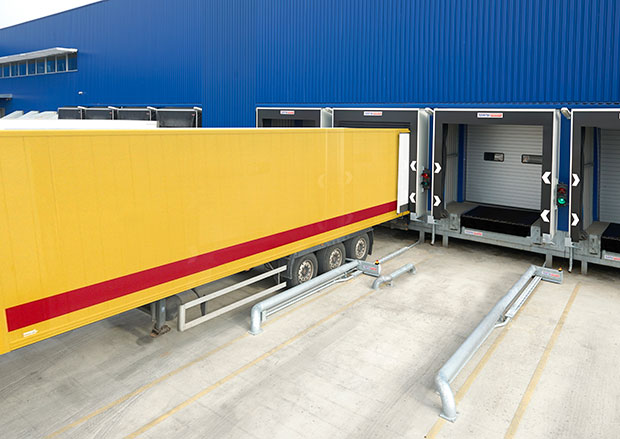Vehicle movement is one of the most significant safety risks in any loading bay. Incidents such as trailer creep or premature drive-offs can lead to serious accidents, damaging equipment and, more importantly, putting staff at risk.

To prevent this, many warehouses and distribution centres are turning to vehicle restraint systems, equipment designed to keep trailers securely in place throughout loading and unloading. But with both automatic and manual systems available, which option is best for your site?
Why Vehicle Restraints Matter
The dangers are well known. A forklift moving in and out of a trailer can gradually cause “trailer creep,” where the vehicle edges away from the dock. Equally, a driver may mistakenly pull away before loading is complete. Miscommunication between warehouse staff and drivers can also have serious consequences.
Vehicle restraints tackle these risks by locking the trailer in position, typically through a blocking arm or wheel chock system. The principle is simple, but the way restraints are deployed varies depending on whether the system is automatic or manual.
Automatic Vehicle Restraints
Automatic systems engage at the push of a button, securing the trailer’s rear wheel without the need for manual intervention. Once in place, the restraint remains locked until released.
The key advantage is consistency. Because the process is automated, engagement happens every time, eliminating the risk of human error. Automatic systems, such as Stertil Dock Products Combilok®, can also be integrated with dock traffic lights and other equipment for a complete solution.
For these reasons, automatic restraints are often chosen by high-throughput operations and distribution centres. While the initial investment is higher, automation delivers efficiency, ease of use, and reduced reliance on staff training.
Manual Vehicle Restraints
Manual systems, such as Stertil’s Combilok M1, work on the same principle but require a staff member to position and engage the restraint. They remain effective when used correctly, and their lower cost makes them attractive to smaller facilities or sites with less frequent traffic.
However, because they rely on staff to deploy them properly every time, manual systems require consistent training and clear procedures. For operations that can support this, they remain a safe and practical option.
Key Comparisons
When weighing up the options, consider:
•Safety: Automatic engagement reduces the chance of human error, while manual systems depend on operators.
•Ease of use: Push-button automation is straightforward; manual systems require positioning.
•Cost: Manual restraints are cheaper upfront; automation delivers long-term efficiency gains.
•Throughput: High-volume sites benefit most from automation, while smaller operations may find manual systems more cost-effective.
Choosing the Right System
There is no one-size-fits-all solution. The right choice depends on the size of your operation, traffic levels, and safety priorities.
For low-traffic sites or tighter budgets, wheel chocks can provide an entry-level option, though they typically offer less protection. For most facilities, however, the decision will hinge on whether the efficiency and integration of automation outweigh the cost savings of a manual system.
What It Means for Your Site
Vehicle restraints are now an essential part of loading bay safety. Whether you choose an automatic or manual solution, ensuring trailers are securely locked during loading is critical to protecting both people and equipment.
Suppliers such as Stertil Dock Products offer a range of options, from fully automated systems for busy distribution centres to manual solutions for smaller warehouses. Whatever the choice, the priority should always be matching the system to your operational needs while keeping safety at the forefront.




Comments are closed.